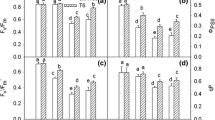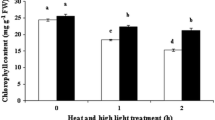Abstract
In recent years, with the global climate change, the intensity, frequency and duration of drought have increased significantly, which has become the main limiting factor for agricultural development in many areas. Glycine betaine (GB) is an effective stress-resistant substance. In this experiment, the effects of the genetic engineering of GB synthesis on photosynthetic apparatus of tobacco under drought stress were studied using transgenic tobacco (T) accumulating GB and wild-type tobacco (K326, WT). Potted tobaccos were subjected to drought stress (controlled irrigation, 25 °C ± 1 °C, a relative humidity: 75–80%) for 9 days, photosynthetic gas exchange parameters, chlorophyll a fluorescence, structure of chloroplast and thylakoid membrane, and protein function of thylakoid membrane were examined under different drought stress time (days). The results showed that T tobacco could accumulate GB and the accumulated GB improved the resistance of the photosynthetic apparatus to drought stress. Under drought stress, the damage of chloroplast and thylakoid lamellae in T tobacco was less than that in WT tobacco, the accumulation of GB in T tobacco could maintain the stability of thylakoid membrane, improved the unsaturated fatty acid index (IUFA) of thylakoid membrane lipid, increased the contents of digalactosyl diacylglycerol (DGDG) and phosphatidylglycerol (PG), and decreased the ratio of monogalactosyl diaylglycerol (MGDG) to DGDG. In addition, under drought stress, the accumulation of GB in T tobacco alleviated the photo-inhibition of PSII, and the increase of xanthophyll cycle de-epoxidation may be one of the reasons for the enhancement of PSII function.










Similar content being viewed by others
References
Adams W III, Muller O, Cohu C, Demmig-Adams B (2013) May photoinhibition be a consequence, rather than a cause, of limited plant productivity? Photosynth Res 117:31–44. https://doi.org/10.1007/s11120-013-9849-7
Arnon DI (1949) Copper enzymes in isolated chloroplasts: polyphenoloxidase in Beta vulgaris. Plant Physiol 24:l–15. https://doi.org/10.1104/PP.24.1.1
Ahmad P, Latef A, Hashem A, Abdallah E, Gucel S, Tran L (2016) Nitric oxide mitigates salt stress by regulating levels of osmolytes and antioxidant enzymes in chickpea. Front Plant Sci 7:347–357. https://doi.org/10.3389/fpls.2016.00347
Chen B, Li JW, Wang XD, Xu ZC (2018) Effects of exogenous selenium on growth and physiological characteristics of flue-cured tobacco under drought stress (in Chinese with English abstract). Plant Physiol J 54(1):165–172. https://doi.org/10.13592/j.cnki.ppj.2017.0427
Cheng LL (2003) Xanthophyll cycle pool size and composition in relation tothe nitrogen content of apple leaves. J Exp Bot 54(381):385–393. https://doi.org/10.1093/jxb/54.381.385
Chen THH, Murata N (2011) Glycinebetaine protects plants against abiotic stress: mechanisms and biotechnological applications. Plant Cell Environ 34:1–20. https://doi.org/10.1111/j.1365-3040.2010.02232.x
Dai LL, Naeem MS, Zhang CL, Liu ZH (2016) Physiological response of photosynthetic apparatus in rapeseed to drought (in Chinese with English abstract). Chin J Oil Crop Sci 38(6):795–803. https://doi.org/10.7505/j.issn.1007-9084.2016.06.013
Demé B, Cataye C, Block MA, Maréchal E, Jouhet J (2014) Contribution of galactoglycerolipids to the 3-dimensional architecture of thylakoids. FASEB J 28:3373–3383. https://doi.org/10.1096/fj.13-247395
Deng LY, Wang HC (1982) Cold hardiness of crape in relation to membrane lipid composition (in Chinese with English abstract). Acta Phytophysiol Sintca 8(3):273–283
Djanaguiraman M, Boyle DL, Welti R, Jagadish SVK, Prasad PVV (2018) Decreased photosynthetic rate under high temperature in wheat is due to lipid desaturation, oxidation, acylation, and damage of organelles. BMC Plant Biol 18:55. https://doi.org/10.1186/s12870-018-1263-z
Djanaguiraman M, Narayanan S, Erdayani E, Prasad PVV (2020) Effects of high temperature stress during anthesis and grain filling periods on photosynthesis, lipids and grain yield in wheat. BMC Plant Biol 20:268. https://doi.org/10.1186/s12870-020-02479-0
Droppa M, Masojidek J, Rózsa Z, Wolak A, Horváth LI, Farkas T, Horváth G (1987) Characteristics of Cu deficiency-induced inhibition of photosynthetic electron transport in spinach chloroplasts. Biochim Biophys Acta 891:75–84. https://doi.org/10.1016/0005-2728(87)90085-5
Du RF, Hao WF, Wang LF (2012) Dynamic responses on anti-oxidative defense system and lipid peroxidation of Lespedeza davurica to drought stress and re-watering (in Chinese with English abstract). Acta Prataculturae Sinic 21(2):51–61
Feng PW (2018) Study on the mechanism of glycinebetaine improve the tolerance of Cd stress in tobacco. M.Sc. thesis, Shandong Agricultural University, Taian, China
Gisselsson SA, Åkerlund HE (2004) Role of histidines in the binding of violaxanthin de-epoxidase to thylakoid membrane as studied by site-directed mutagenesis. Physiol Plant 122:337–343. https://doi.org/10.1111/j.1399-3054.2004.00415.x
Gilmore AM, Yamamoto HY (1991) Resolution of lutein and zeaxanthin using a non-endcapped, lightly carbon-loaded C18 high-performance liquid chromatographic column. J Chromatogr 543:137–145. https://doi.org/10.1016/S0021-9673(01)95762-0
Gong T, Liu SL, Yin GZ, He D, Zhang QP, Zong XF (2017) Effects of water stress on growth, photosynthetic characteristics and quality of tobacco (in Chinese with English abstract). J SW Chin Norm Univ (nat Sci Ed) 42(8):64–69. https://doi.org/10.13718/j.cnki.xsxb.2017.08.012
Gounaris K, Mannock DA, Sen A, Brain APR, Williams WP, Quinn PJ (1983) Polyunsaturated fatty acyl residues of galactopipids are involved in the control of bilayer/non bilayer lipid transition in higher plant chloroplasts. Biochim Biophys Acta 732:229–242. https://doi.org/10.1016/0005-2736(83)90207-9
Havaux M, Bonfils JP, Lütz C, Niyogi KK (2000) Photodamage of the photosynthetic apparatus and its dependence on the leaf developmental stage in the npq1 Arabidopsis mutant deficient in the xanthophyll cycle enzyme violaxanthin de-epoxidase. Plant Physiol 124:273–284. https://doi.org/10.1104/pp.124.1.273
Huang S, Zuo T, Ni WZ (2020) Important roles of glycinebetaine in stabilizing the structure and function of the photosystem II complex under abiotic stresses. Planta 251:36. https://doi.org/10.1007/s00425-019-03330-z
Hu W, Kang J, Liu Y, Chen X, Dong AW (2013) The effect of drought stress on photosynthetic physiological characteristics of the different tobacco varieties (in Chinese with English abstract). Chin Tobacco Sci 34(2):67–73. https://doi.org/10.3969/j.issn.1007-5119.2013.02.015
Janik E, Bednarska J, Zubik M, Puzio M, Luchowski R, Grudzinski W, Mazur R, Garstka M, Maksymiec W, Kulik A (2013) Molecular architecture of plant thylakoids under physiological and light stress conditions: a study of lipid-light-harvesting complex II model membranes. Plant Cell 25:2155–2170. https://doi.org/10.1105/tpc.113.113076 (Epub 28 Jun 2013)
Kobayashi K (2016) Role of membrane glycerolipids in photosynthesis, thylakoid biogenesis and chloroplast development. J Plant Res 129:565–580. https://doi.org/10.1007/s10265-016-0827-y
Krause GH, Jahns P (2003) Pulse amplitude modulated chlorophyll fluorometry and its application in plant science. In: Green BR, Parson WW (eds) Light-harvesting antennas in photosynthesis. Kluwer, Dordrecht, pp 373–399
Li XH, Xia ZL, Yu QW, Wang J, Wang ZW, Di WU, Dai LH, Yuan LI, Tian MZ, Liu RX (2019) Evaluation essay for drought tolerance of tobacco varieties at different developmental stages (in Chinese with English abstract). J Mountain Agri Biol 38(1):35–42. https://doi.org/10.15958/j.cnki.sdnyswxb.2019.01.007
Li D, Shen HT, Wang YF, Wang Y, Wang LJ, Zhao SM, Liu L (2021) Effects of exogenous melatonin on photosynthetic carbon assimilation and endogenous hormones in tobacco seedlings under drought stress (in Chinese with English abstract). Acta Pratacul Sin 30(1):130–139. https://doi.org/10.11686/cyxb2020070
Li GF, Wang RH, Wang ZB (2015) Effect of NaHSO3 on photosynthesis and chlorophyll fluorescence of apple. Acta Agriculturae Boreali-Occidentalis Sinica 24(5):75–80. https://doi.org/10.7606/j.issn.1004-1389.2015.05.013
Liu L, Li D, Ma YL, Wang LJ, Zhao SM, Zhou JX, Shen HT, Wang YF (2019) Alleviation of drought stress and the physiological mechanism in tobacco seedlings treated with exogenous melatonin (in Chinese with English abstract). Acta Pratacul Sin 28(8):95–105. https://doi.org/10.11686/CYXB2019098
Luo D, Niu XL, Yu JD, Yan J, Gou XJ, Lu BR, Liu YS (2012) Rice choline monooxygenase (OsCMO) protein functions in enhancing glycine betaine biosynthesis in transgenic tobacco but does not accumulate in rice (Oryza satia L. ssp. japonica). Plant Cell Rep 31(9):1625–1635. Doi: https://doi.org/10.1007/s00299-012-1276-2
Ma XL, Wang YJ, Xie SL, Wang C, Wang W (2007) Glycinebetaine application ameliorates negative effects of drought stress in tobacco. Russ J Plant Physiol 54:472–479. https://doi.org/10.1134/S1021443707040061
Nuccio ML, Russell BL, Nolte KD, Rathinasabapathi B, Gage DA, Hanson AD (1998) The endogenous choline supply limits glycine betaine synthesis in transgenic tobacco expressing choline monooxygenase. Plant J 16:487–496. https://doi.org/10.1046/j.1365-313x.1998.00316.x
Pei LM, Li H, Zhou YY, Li WJ, Jiang YH, Li H (2020) Exogenous glycinebetaine application contributes to abiotic stress tolerance in maize. J Plant Biol. https://doi.org/10.1007/s12374-020-09265-3
Tieleman DP, Marrink SJ, Bertendsen HJ (1997) A computer perspective of membranes: molecular dynamics studies of lipid bi-layer systems. Biochim Biophys Acta 1331(3):235–270. https://doi.org/10.1016/S0304-4157(97)00008-7
Wang FZ, Jin YN, Li ZW, Chen B, Xiong YN, Hao HH, Xu ZC (2020a) Effects of Exogenous ALA (5-aminolevulinic acid) on photosynthesys and antioxidant system of flue-cured tobacco seedlings under drought stress (in Chinese with English abstract). Chin Tobacco Sci 41(1):22–29. https://doi.org/10.13496/j.issn.1007-5119.2020.01.004
Wang GP, Li F, Zhang J, Zhao MR, Hui Z, Wang W (2010) Overaccumulation of glycine betaine enhances tolerance of the photosynthetic apparatus to drought and heat stress in wheat. Photosynthetica 48(1):30–41. https://doi.org/10.1007/s11099-010-0016-5
Wang GP, Wang JZ, Xue XM, Lu C, Chen R, Wang LP, Han XP (2020b) Foliar spraying of glycine betaine lowers photosynthesis inhibition of Malus hupehensis leaves under drought and heat stress. Intl J Agric Biol 23:1121–1128. https://doi.org/10.17957/IJAB/15.1393
Wei D, Zhang W, Wang C, Meng Q, Li G, Chen THH, Yang X (2017) Genetic engineering of the biosynthesis of glycinebetaine leads to alleviate salt-induced potassium efflux and enhances salt tolerance in tomato plants. Plant Sci 257:74–83. https://doi.org/10.1016/plantsci.2017.01012
Wen XG, Qiu NW, Lu QT, Lu CM (2005) Enhanced thermotolerance of photosystem II in salt-adapted plants of the halophyte artemisia anethifolia. Planta 220:486–497. https://doi.org/10.1007/s00425-004-1382-7
Williams WP (1998) The physical properties of thylakoid membrane lipids and their relation to photosynthesis. In: Siegenthaler PA, Murata N (eds) Advances in Photosynthesis. Lipids in Photosynthesis. Kluwer Academic Publ, The Dordrecht, pp 103–118
Wu S, Su Q, An LJ (2010) Isolation of choline monooxygenase (CMO) gene from Salicornia europaea and enhanced salt tolerance of transgenic tobacco with CMO genes. Indian J Biochem Biophys 47(5):298–305. https://doi.org/10.1007/s00249-010-0598-7
Xu DH, Fang XW, Bin ZJ, Wang G, Su PX (2012) Ecophysiological mechanism of Caragana korshinskii Kom adaptation to extreme drought stress—leaf abscission and keeping chloroplast integrity in stem (in Chinese with English abstract). J Desert Res 32(3):691–697
Yang XH, Liang Z, Lu CM (2005) Genetic engineering of the biosynthesis of glycinebetaine enhances photosynthesis against high temperature stress in transgenic tobacco plants. Plant Physiol 138:2299–2309. https://doi.org/10.1104/pp.105.063164
Yang XH, Liang Z, Wen XG, Lu CM (2008) Genetic engineering of the biosynthesis of glycinebetaine leads to increased tolerance of photosynthesis to salt stress in transgenic tobacco plants. Plant Mol Biol 66:73–86. https://doi.org/10.1007/s11103-007-9253-9
Ye JY, Qian YQ (ed) (1985) Techniques of plant physiological experiments. Shanghai Scientific and Technical Publ., Shanghai, pp 104–107 (In Chinese)
Yu B, Benning C (2003) Anionic lipids are required for chloroplast structure and function in Arabidopsis. Plant J 36:762–770. https://doi.org/10.1046/j.1365-313X.2003.01918.x
Yin ZP, Wang ZQ, Qi MF, Meng SD, Li TL (2019) Effects of melatonin application on photosynthetic function in tomato seedlings under salt stress (in Chinese with English abstract). Chin J Ecol 38(2):467–475. https://doi.org/10.1111/j.1600-079X.2012.01008.x
Zhao L, Zhou Y, Wang HY, Shi HZ, Zhao SM, Chang LK, Yang QM, Yang HJ (2019) Research on the differential physiological responses in different fluecured tobacco lines under drought stress (in Chinese with English abstract). J Nucl Agri Sci 33(3):607–615. https://doi.org/10.11869/j.issn.100-8551.2019.03.0607
Acknowledgements
This research was supported by the Youth Research Fund of the Shandong Institute of Pomology (2018KY07) and the earmarked fund for the China Agriculture Research System (CARS-27).
Author information
Authors and Affiliations
Contributions
GPW and XHY conceived and designed the experiments; GPW, XMX, RC and XPH performed the experiments; GPW analyzed the data; GPW, XMX and XHY, contributed the reagents, materials, and analysis tools; GPW wrote the paper.
Corresponding author
Ethics declarations
Conflict of interest
The authors have declared no conflicts of interest.
Additional information
Publisher's Note
Springer Nature remains neutral with regard to jurisdictional claims in published maps and institutional affiliations.
Rights and permissions
About this article
Cite this article
Wang, GP., Xue, XM., Yang, Xh. et al. The genetic engineering of glycine betaine synthesis in tobacco improves the resistance of the photosynthetic apparatus to drought stress. Plant Biotechnol Rep 16, 229–242 (2022). https://doi.org/10.1007/s11816-022-00747-z
Received:
Revised:
Accepted:
Published:
Issue Date:
DOI: https://doi.org/10.1007/s11816-022-00747-z




